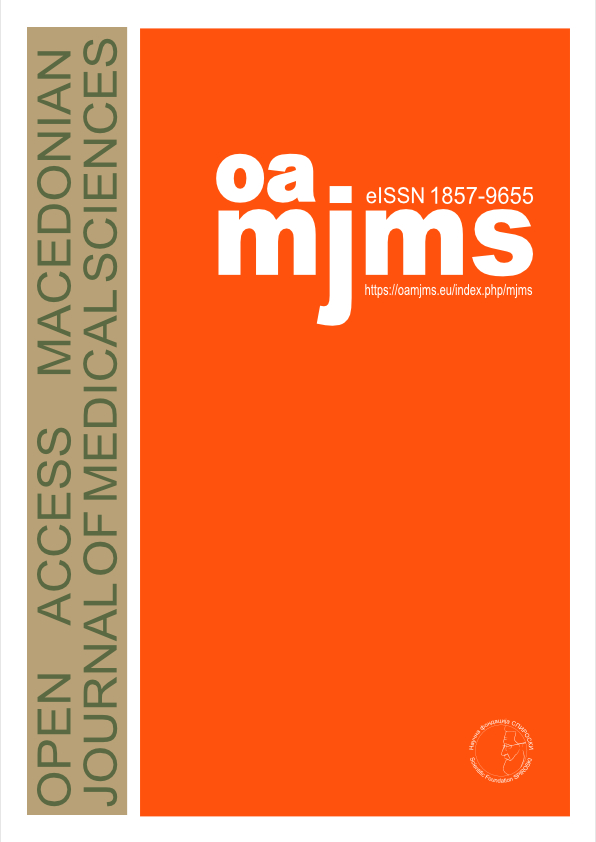Allogeneic Stem Cell Transplantation in the Treatment for Transfusion-Dependent Thalassemia: Centre Experience
DOI:
https://doi.org/10.3889/oamjms.2024.11994Keywords:
thalassemia, allogeneic stem cell transplantation, conditioning, matched related donorAbstract
BACKGROUND: Allogeneic stem cell transplantation (allo SCT) is still the only curative option for transfusion depended on β-thalassemia major (TDT). In patients with good risk features it is reasonable to anticipate a greater than 90% chance of a successful transplant outcome. With better risk stratification and supportive care, the results of allo-SCT have been improved even in high risk patients who have significant iron overload related organ dysfunction. Choosing the optimal conditioning regimen before allo SCT, stem cell source and focusing on transfusion free survival, as well as graft versus host disease (GVHD) free survival is a challenge in providing the quality of life in the post-transplant period for this indication. The aim of this article is to present first experience in the treatment of TDT with allo SCT from matched related donor (MRD).
CASE PRESENTATION: We present a case of male patient diagnosed as thalassemia major (TM) at the age of 15 years referred at University Clinic for pediatric disease in Skopje, Republic of North Macedonia for treatment with allogeneic stem cell transplantation (allo SCT) from matched related family donor (MRD). Patients experienced two allo SCT due to early graft rejection after the first transplantation. The conditioning was done with MAC regimens, busulfan based for the first transplant and treosulfan based for the second transplant.
CONCLUSION: Disease severity and the age of the patient has a crucial impact on transplant related mortality (TRM), event free survival (EFS) and the incidence of veno-oclusive liver disease as one of the main complications during SCT. More data is required on the etiology of frequent graft rejection in TDT studying the aspects of the graft and subsequent immune reconstitution that can improve the outcome of allo HSCT for thalassemia major.
Downloads
Metrics
Plum Analytics Artifact Widget Block
References
Oikonomopoulou C, Goussetis E. HSCT remains the only cure for patients with transfusion - dependent thalassemia until gene therapy strategies are proven to be safe. Bone Marrow Transplant. 2021; 56(12): 2882 - 2888. https://doi.org/10.1038/s41409-021-01461-0 PMid:34531544 DOI: https://doi.org/10.1038/s41409-021-01461-0
Yesilipek MA et al. Thalassemia-free and graft-versus-host-free survival: outcomes of hematopoietic stem cell transplantation for thalassemia major, Turkish experience. Bone Marrow Transplant. 2022;57(5):760-767. https://doi.org/10.1038/s41409-022-01613-w PMid:35210564 DOI: https://doi.org/10.1038/s41409-022-01613-w
Locatelli F, Merli P, Strocchio L. Transplantation for thalassemia major: alternative donors. Curr Opin Hematol. 2016;23(6):515-523. https://doi.org/10.1097/MOH.0000000000000280 PMid:27537474 DOI: https://doi.org/10.1097/MOH.0000000000000280
Santarone S et al. Survival and late effects of hematopoietic cell transplantation in patients with thalassemia major. Bone Marrow Transplant. 2022; 57:1689-1697. https://doi.org/10.1038/s41409-022-01786-4 PMid:36002533 PMCid:PMC9400570 DOI: https://doi.org/10.1038/s41409-022-01786-4
EUR-Lex. 32016L1214-EN-EUR-Lex. Available at: https://eur-lex.europa.eu/eli/dir/2016/1214/oj/eng
Cappelli B et al. Risk factors and outcomes according to age at transplantation with an HLAidentical sibling for sickle cell disease. Haematologica. 2019;104(12):e543-6 https://doi.org/10.3324/haematol.2019.216788 PMid:31018975 PMCid:PMC6959194 DOI: https://doi.org/10.3324/haematol.2019.216788
Cappelli B et al.The EBMT Handbook: Hematopoietic Cell Transplantation and Cellular Therapies [Internet]. 8th edition. Cham (CH): Springer, 2024; 80.
Lüftinger R et al. Busulfan-fludarabine- or treosulfan-fludarabine-based myeloablative conditioning for children with thalassemia major. Ann Hematol. 2022;101(3):655-665. https://doi.org/10.1007/s00277-021-04732-4 PMid:34999929 DOI: https://doi.org/10.1007/s00277-021-04732-4
Chen H et al. Prediction, management, and prognosis of mixed chimerism after hematopoietic stem cell transplantation in transfusion - dependent pediatric thalassemia patients. Pediatr Transplant. 2020;24(8):e13876. https://doi.org/10.1111/petr.13876 PMid:33098346 DOI: https://doi.org/10.1111/petr.13876
Susu Gong et al. Uniform Graft-versus-Host Disease Prophylaxis using Post -Transplantation Cyclophosphamide, Methotrexate, and Cyclosporine following Peripheral Blood Hematopoietic Stem Cell Transplantation from Matched and Haploidentical Donors for Transfusion-Dependent Thalassemia: A Retrospective Report from the Bone Marrow Failure Working Group of Hunan Province, China. Transplantation and Cellular Therapy, 2024. https://doi.org/10.1016/j.jtct.2024.08.022 https://doi.org/10.1016/j.jtct.2024.08.022 PMid:39236789 DOI: https://doi.org/10.1016/j.jtct.2024.08.022
Downloads
Published
How to Cite
License
Copyright (c) 2024 Aleksandra Pivkova-Veljanovska, Lazar Chadievski, Bozidar Kocoski, Milche Cvetanoski, Sanja Trajkova, Svetlana Krstevska-Balkanov, Nevenka Ridova, Simona Stojanoska, Tara Ristevska, Martin Stojanoski, Merve Purde, Zaklina Trajkovska-Ancevska, Irina Panovska-Stavridis (Author)

This work is licensed under a Creative Commons Attribution-NonCommercial 4.0 International License.
http://creativecommons.org/licenses/by-nc/4.0







